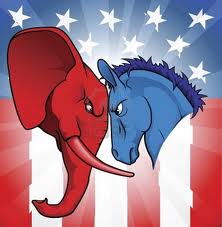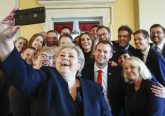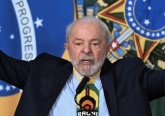 Mitt Romney and Barack Obama not only have different blueprints for America. They also have different blueprints for their campaigns for President of the United States of America.
Mitt Romney and Barack Obama not only have different blueprints for America. They also have different blueprints for their campaigns for President of the United States of America.
Look for example at the four key elements of message (PR), money (fundraising), media (advertising), and mobilization (field operations/get-out-the-vote).
The Obama re-election effort is, arguably to an even greater extent than David Plouffe has already acknowledged the 2008 campaign was, modeled on George W. Bush’s 2004 campaign:
- In terms of message, the goal is to paint Romney (then John Kerry) early as a man of questionable character unfit for the presidency, present Obama (Bush) as a man of principle who you may not like but who is doing what he believes is right and who will stay the course, and thus define the election not as a referendum on the sitting President but as “the clearest choice of any time in a generation” between the two candidates.
- In terms of money, the campaign is walking on two legs, simultaneously using the advantages of incumbency to pursue big-dollar donors while also mining the wide network of small-dollar donors already built during previous cycles. Between them, the Obama campaign, the Democratic National Committee, and Priorities USA, the main pro-Obama “super PAC) are on course to raise something in the region of $900 million dollars by Election Day.
- In terms of media, the campaign and its closest associates has aggressively used its ability to spend early to try to define Romney before he could start using funds from his general election account to really present himself to the American people. This means the Obama campaign has had a high burn-rate and may be at a slight disadvantage when it comes to paid media in the final weeks, but also that many people have had a (negative) view of Romney from well before the Republican convention.
- In terms of mobilization, the campaign is trying to keep the key elements of the field operation under their own control, leveraging the amazing staff, volunteer, and targeting infrastructure built in 2008 and further refined in the years since, and using the stark choice between Obama and Romney to try to fire up an activist base who may have mixed feelings about the President’s first term.
The Romney campaign, in contrast, has so far chartered a quite different course:
- In terms of message, the overarching narrative so far has been a referendum on the President’s performance on the economy and job creation—the famous “are you better off than four years ago”-question—and not a choice between two candidates. (With the campaign off balance and the Republican nominee behind in the polls, many in the party are pushing for a more positive and specific arguments for why people should vote for Romney.)
- In terms of money, the campaign has tapped into a network of wealthy big-dollar donors and done very, very well to keep up with—and sometimes surpass—Obama’s fundraising. Between them, the Romney campaign, the Republican National Committee, and Restore Our Future, the main pro-Romney “super PAC”, have more or less kept pace with the President and his closest allies, raising well over $600 million so far. But the money comes from fewer donors, many of whom have already given the maximum amount they can to the campaign itself, leaving them to explore alternative options such as outside political action committees if they want to give more. The main Republican operations have received much less from small-dollar donors. Importantly, the money has been raised across a number of different organizations who are legally prohibited from coordinating their efforts, complicating things in the final weeks.
- In terms of media, the Romney campaign has spent less than the President and his allies. The Republican nominee has talked about spending money “wisely” and campaign insiders have insisted that they are not so much behind as keeping their powder dry for the home stretch where they may well have an advantage in terms of raw financial muscle. (This reflects different strategic analysis. The Romney campaign seems cognizant of the rather short half-life of the direct effect television advertising has on voters’ behavior and the Obama campaign focused on the declining rates of return of increased spending.)
- In terms of mobilization, the Romney campaign is, by all accounts, clearly superior to the 2008 McCain operation, but is still nowhere near the scale and scope of the Obama field operation. (In part this reflects that Romney has had less time to plan as he had to navigate the primary, but also, as I noted in April, that the campaign has not prioritized using the primary as a way of building an operation for the general election, the way Obama did in 2008.) Instead, Romney will have to bank on the efforts of outside groups including not only the national party, but also Americans for Prosperity, the National Rifle Association, and the Christian Coalition. As the Democratic Party and its allies learned in 2004, it is very hard to integrate such efforts in ways that are both legal and effective.
Till the last week or so, the Romney campaign has been praised for its calm, discipline, and professionalism, but when one adopts a wider, organizational, perspective, it is clear that the main components of the Obama campaign are much more integrated, centralized and controlled than the more sprawling assemblage of different aligned and often well-resourced, but ultimately independent, groups backing the Republican nominee—not unlike the difference between the Bush and Kerry campaigns in 2004, in fact.
Why does this matter? Some political scientists studying elections argue that campaigns don’t matter much. The underlying logic of this stance is articulated with characteristic clarity by Larry Bartels, who has written: “In a world where most campaigners make reasonably effective use of reasonably similar resources and technologies most of the time, much of their effort will necessarily be without visible impact, simply because every campaigner’s efforts are balanced against more or less equally effective efforts to produce the opposite effect.”
But, as we can see again this year, there is little evidence to suggest we live in such a world. Competing campaigns often have different resources and technologies, use them in different ways, and are not always equally effective. Hence we need to understand how they work, and their efforts are unlikely to simply balance each other.
Dr Rasmus Kleis Nielsen is Research Fellow at the Reuters Institute for the Study of Journalism (University of Oxford) and an assistant professor of communications at Roskilde University (RUC) in Denmark.
His book, Ground Wars: Personalized Communication in Political Campaigns, deals with how American political campaigns mobilize, organize, and target their field operations, using large numbers of volunteers and paid part-timer workers to contact voters at home at the door or over the phone. It has been published by Princeton University Press and is available on Amazon.
Cross-posted to rasmuskleisnielsen.net








1 Comment